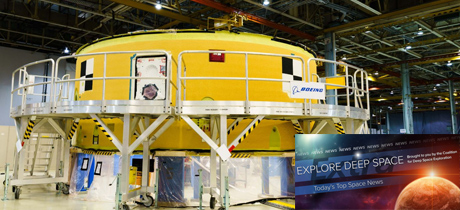In Today’s Deep Space Extra… NASA’s planned human tended Gateway has experts discussing the possibilities as well as the challenges. NASA pushing science potential for small satellites. The Perseid meteor show peaks.
Human Space Exploration
First major piece of NASA’s Space Launch System (SLS) assembled
Coalition Member in the News – Boeing
Spaceflightinsider.com (8/5): Boeing has completed the assembly of the first Space Launch System (SLS) core stage component, the forward skirt, at NASA’s Michoud Assembly Facility in New Orleans. The core is to fly the first SLS test flight, Exploration Mission-1 (EM-1), which is to send an uncrewed Orion capsule around the moon and back to Earth for an ocean recovery between late 2019 and mid-2020.
NASA could have people living on the Moon in 8 years, and that’s just the beginning
Time (7/19): NASA’s White House back-to-the-moon strategy to develop a human tended Gateway during the 2020s, promises access to unexplored regions of the Moon, for scientific research and the testing of landers, habitats, robotic rovers and power systems needed for the exploration of Mars. The Gateway may serve as a depot for resources recovered from the moon as well as a departure point for the human transports headed to Mars.
Why getting back to the moon is so damn hard
MIT Technology Review (8/2): A post-Apollo return to the moon proved just beyond the reach of the private sector contestants for the recently suspended $20 million Lunar X-Prize. Can a public/private partnership strategy like that proposed by the White House for the 2020s work? A significant cost challenge is rooted in the infrastructure, NASA’s Space Launch System (SLS), the human tended Gateway and Orion capsule to make the return a sustainable one and establish a business case for investors who can ensure the private sector makes a significant contribution.
SpaceX organizes inaugural conference to plan landings on Mars
Ars Technica (8/6): SpaceX is hosting a “Mars Workshop” Tuesday and Wednesday at the University of Colorado, Boulder. Some 60 scientists and engineers from the aerospace industry and academia as well as government have been invited to the conference, according to the report, which adds that attendees are being asked to not publicize the workshop or their attendance.
Space Science
Why Goodyear and Delta Faucet are doing research in space
CNN Money (8/5): The large companies Goodyear and Delta Faucet have signed on for experiments aboard the International Space Station this year that could improve the fuel efficiency of road tires and improve low flow shower heads.
NASA bolsters smallsat science programs
Space New (8/6): NASA’s Science Mission Directorate plans to invest $100 million annually to advance the science capabilities of small satellites. The effort will include technology demonstrations and launch opportunities. Thomas Zurbuchen, NASA’s associate administrator for science, explained the effort before the Utah State University Conference on Small Satellites underway this week.
The Perseid meteor shower is underway
Spaceweather.com (8/6): The annual Perseid meteor shower is one of the Earth’s most visible and is sourced by debris from the tail of the comet Swift-Tuttle. The shower peaks this weekend and plenty of fireballs have been detected so far.
Other News
Space Florida proposes launch, landing pads at KSC
Coalition Member in the News – Boeing
Florida Today (8/5): Space Florida, the state economic development agency, is proposing the construction of a launch complex for Boeing’s reusable Phantom Express space plane and three landing pads for reusable Blue Origin and SpaceX rockets and small launch vehicles. The proposal is under review by NASA’s Kennedy Space Center.
Spaceflight gears up for dedicated Falcon 9 launch
Space News (8/6): Spaceflight plans a SpaceX Falcon 9 mission later this year dedicated to a small satellite payload. Launching from Vandenberg Air Force Base, California, the rocket is to place 71 small sats into a sun synchronous orbit, the largest ride share ever. The plan was announced at the Utah State University Conference on Small Satellites underway this week.

